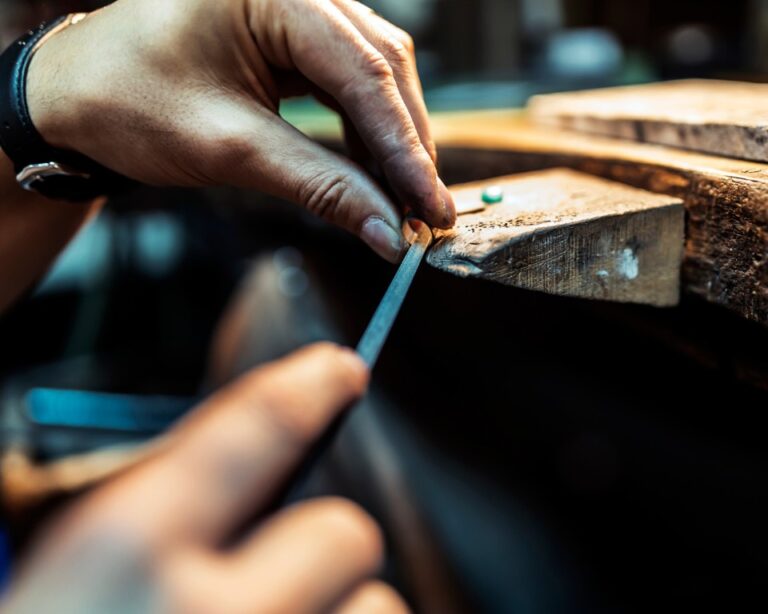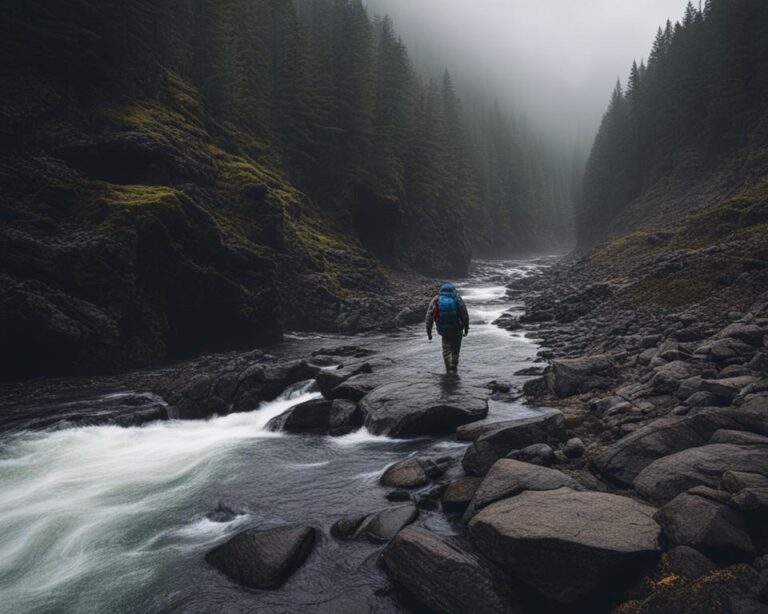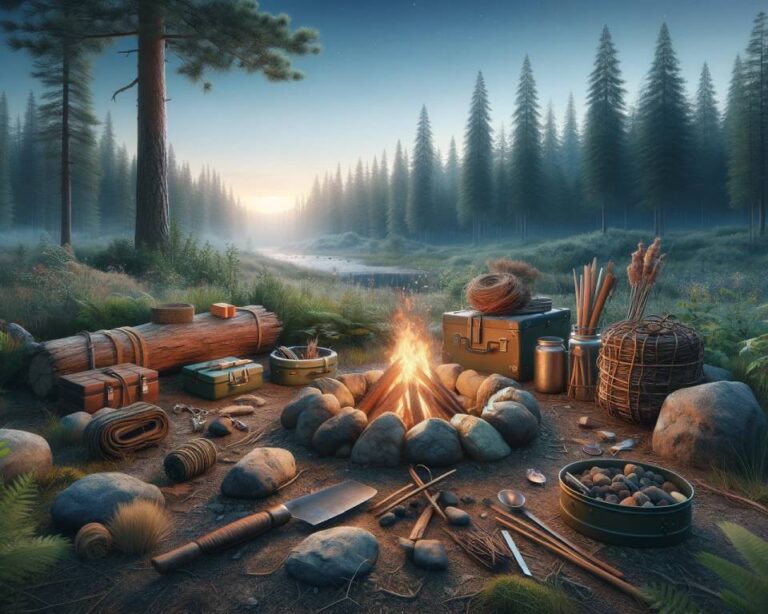Bushcraft Basics: Essential Skills for the Wild
In today’s fast-paced world, venturing into the wilderness allows us to reconnect with nature and challenge ourselves mentally and physically. But when we step into the wild, modern conveniences are left behind, and it’s essential to rely on our bushcraft skills for survival and comfort.
Bushcraft skills, also known as primitive skills or pioneer skills, were once necessary for our ancestors’ survival. Today, they serve as a way to connect with our roots and gain self-reliance in the great outdoors. Whether you’re a beginner or an experienced outdoor enthusiast, learning and practicing bushcraft skills is essential for both recreation and emergency preparedness.
In this article, we will explore the essential bushcraft skills needed in the wild. From setting up a campsite to sourcing water, starting a fire, building a shelter, and foraging for food, we will guide you through the fundamental skills that will make your time in the woods safe, enjoyable, and fulfilling.
Key Takeaways:
- Mastering bushcraft skills is important for both recreation and emergency preparedness.
- Choosing the right campsite involves considering factors like firewood availability, wind direction, and water sources.
- Bushcraft knife skills include safe grips, carving, and sharpening techniques.
- Proper technique, safety precautions, and maintenance are vital for mastering bushcraft axe skills.
- Understanding how to use a saw properly is crucial for bushcraft saw skills.
Bushcraft Camping Skills – Campsite Selection
Choosing the right campsite is a critical aspect of bushcraft camping skills. Whether you’re planning a weekend getaway or embarking on a longer wilderness adventure, proper campsite selection ensures a safe and comfortable experience. Here are some factors to consider when choosing your campsite:
Length of Stay
Consider the duration of your camping trip. If you’re staying for a short period, a smaller campsite with minimal amenities may suffice. However, for longer stays, it’s important to choose a campsite that offers the necessary resources and facilities.
Availability of Firewood
When practicing bushcraft skills, having access to firewood is crucial. Look for campsites where firewood is readily available either by natural means or provided by the campsite.
Wind Direction
Consider the prevailing wind direction in the area when selecting your campsite. Choosing a spot that offers natural wind protection can help keep your campfire and tent smoke-free.
Elevation
Understanding the elevation of your campsite is important for various reasons. Higher elevations may offer cooler temperatures, while lower elevations might have higher humidity levels. Additionally, consider the accessibility and terrain challenges associated with different elevation levels.
Water Source
Access to clean water is essential during your camping trip. Look for campsites near reliable water sources such as rivers, lakes, or streams. Ensure you have the necessary equipment and knowledge for water purification if needed.
Overhead Hazards
Identify potential overhead hazards in the area before setting up your campsite. Avoid camping under dead or leaning trees, as they pose a risk of falling branches or trunks.
Local Regulations
Always comply with local regulations and restrictions when choosing a campsite. Check for any permits required and respect the designated camping areas to preserve the environment and ensure a positive outdoor experience for all.
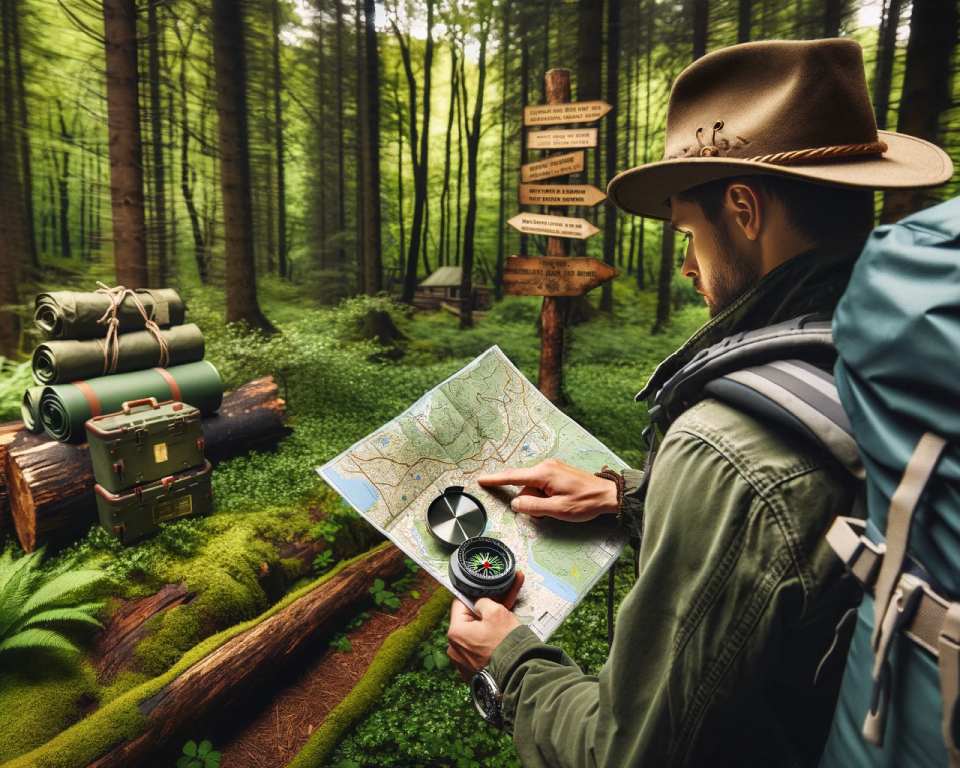
By considering these factors, you can select a campsite that meets your needs and enhances your bushcraft camping skills. Remember, camping essentials go beyond equipment and gear; proper campsite selection plays a vital role in your overall camping experience.
Bushcraft Knife Skills – Knifecraft
Using a bushcraft knife is essential for various tasks in the wilderness. Whether you’re carving, batoning wood, cutting notches, shaving bark, or cutting holes in sticks, having the right knife skills is crucial. It’s not just about getting the job done; it’s about doing it efficiently and safely.
When it comes to bushcraft knife skills, one of the first things to learn is the proper grip. Holding the knife correctly allows for better control and reduces the risk of accidents. Practice different grips and find the one that feels most comfortable for you.
Carving is a fundamental skill in knifecraft. It allows you to shape wood for various purposes, from creating tools to crafting intricate designs. Start with simple projects and gradually work your way up to more complex carvings.
Batoning wood is another essential knife technique. It involves using the knife and a baton to split wood lengthwise, which is useful for making kindling or larger pieces for firewood. Mastering this skill will save you energy and time when gathering wood for your campfire.
Cutting notches is a versatile knife skill that is used in various bushcraft applications. Notches can be used for joining pieces of wood, creating traps, or constructing shelters. Practice making different types of notches and learn how they can be applied in different situations.
Shaving bark is a valuable skill for making tinder bundles to start fires or for crafting containers and utensils. Using controlled knife strokes, remove thin layers of bark from a tree without damaging it. Keep practicing to achieve smooth and even shavings.
Cutting holes in sticks is a technique that comes in handy when making traps, constructing tools, or creating functional gear. Use your knife to carefully carve out holes of various sizes in wooden sticks. Learning this skill will expand your options for wilderness projects.
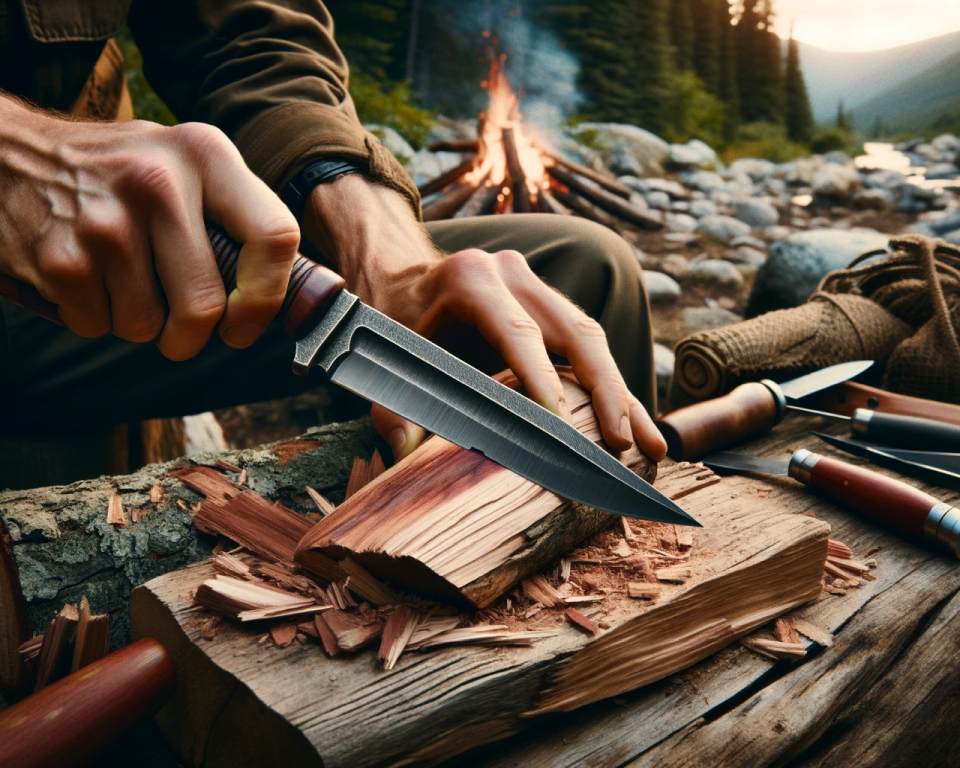
Sharpening your knife is an essential aspect of knifecraft that should not be overlooked. A sharp knife is safer and more effective. Invest in a high-quality knife sharpener and learn how to properly maintain the sharpness of your blade.
Remember, mastering bushcraft knife skills takes time and practice. Start with small projects and gradually progress to more advanced techniques. Always prioritize safety and be mindful of your surroundings. With a well-honed knife and the right skills, you’ll be better equipped for the challenges of the wilderness.
Bushcraft Axe Skills – Axecraft
When it comes to bushcraft, mastering axe skills is essential for wilderness survival. A bushcraft axe is a versatile tool that can be used for a range of tasks, including cutting down trees, limbing, splitting wood, carving tools, notching logs, and even serving as a hammer. Axecraft is a fundamental skill that every outdoor enthusiast should learn.
Proper technique is key to effectively and safely using a bushcraft axe. To maximize efficiency and minimize the risk of injury, it is crucial to master the correct grip, stance, and swing. Learning different chopping techniques, such as the power chop and controlled chop, will enable you to make precise cuts while conserving energy.
Safety is paramount when working with any cutting tool, and the same applies to a bushcraft axe. Always wear protective gear, such as gloves and eye protection. Before starting any task, ensure that the area is clear of obstacles and other people. Maintain a safe distance between yourself and others to avoid accidents. Regularly inspect your axe for any damage and keep the blade sharp to prevent accidents caused by slippage.
Maintenance is another crucial aspect of axecraft. Keep your axe clean and dry to prevent rusting. Apply a thin coat of oil to the blade and store it in a sheath or cover when not in use. Regularly check the axe handle for splintering or cracking and replace it if necessary. By properly maintaining your axe, you can prolong its lifespan and ensure optimal performance in the wilderness.
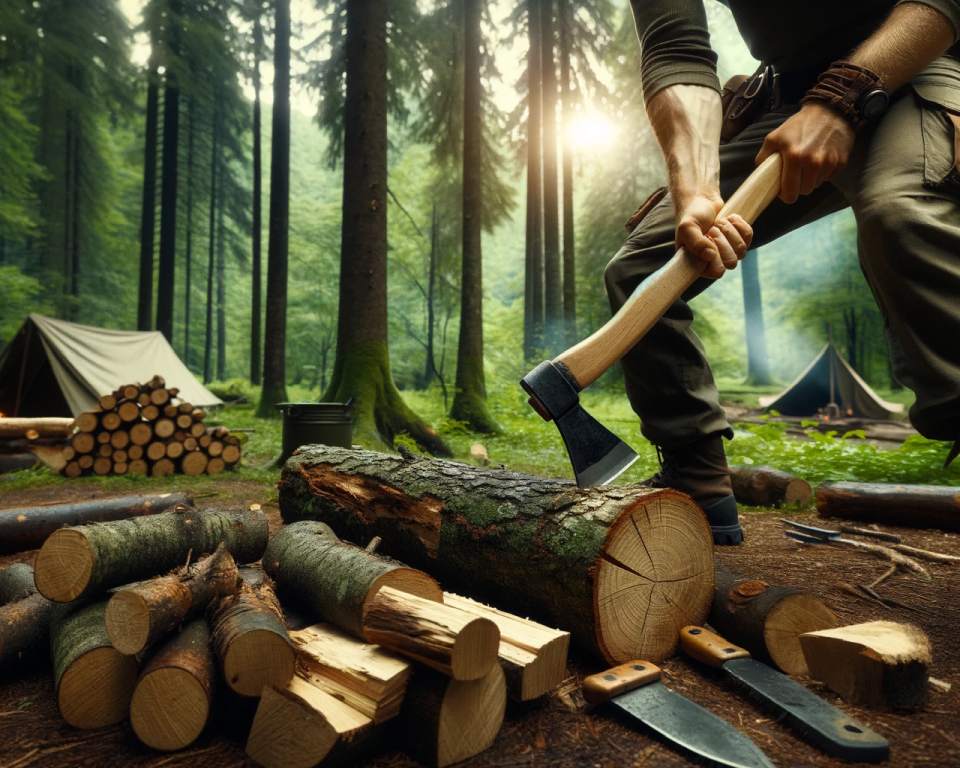
By honing your bushcraft axe skills through practice and training, you will become proficient in handling this essential tool. Remember, axecraft is not only about chopping wood – it’s about developing the confidence and expertise to rely on your skills in the great outdoors.
Bushcraft Saw Skills – Sawcraft
When venturing into the wilderness, mastering bushcraft saw skills is essential for various tasks that require cutting wood and processing timber. Whether you’re felling trees, limbing branches, splitting firewood, notching logs, or working with deadfall, having proficiency in using a bushcraft folding saw or a bow saw is crucial.
The proper technique is vital when using a saw in bushcraft. Ensuring a stable grip, positioning the saw correctly, and using the appropriate motion can make a significant difference in efficiency and safety. Whether you’re a beginner or have some experience, a good technique will help you accomplish tasks more effectively.
Choosing the right saw blade is also important. Different saw blades are designed for specific purposes, such as cutting green wood, dry wood, or performing fine woodworking tasks. Understanding the characteristics of each blade type and selecting the appropriate one for your intended task will enhance your sawcraft capabilities.
Maintaining a sharp saw blade is crucial for optimal performance. A dull blade can hinder productivity and create safety hazards. Sharpening the saw regularly helps maintain its cutting efficiency and prolong its lifespan. Whether you’re using a file, a sharpening stone, or specialized tools for saw maintenance, regular maintenance ensures you’re always ready for your bushcraft adventures.
“Mastering bushcraft saw skills opens up a world of possibilities in the wilderness. With the right technique, blade selection, and maintenance, you’ll be able to conquer any woodcutting task efficiently and with confidence.”
So, whether you’re building a shelter, creating campfire fuel, or crafting tools and utensils, honing your sawcraft skills is vital for your outdoor survival journey. Remember, safety should always be a top priority. Practicing these skills in a controlled environment and seeking guidance from experienced bushcraft enthusiasts or instructors can help you cultivate your sawcraft expertise.
Next, we’ll delve into another crucial aspect of bushcraft: fire starting skills. In section 6, we’ll explore the art of firecraft, including various techniques and methods to ignite and maintain fires in the wilderness.
Bushcraft Fire Starting Skills – Firecraft
Starting and maintaining a fire is crucial for survival in the wilderness. We must possess essential bushcraft fire starting skills to ensure our safety and comfort during outdoor adventures. From finding natural dry fire tinder to understanding fire safety, let’s explore the skills that will help us master the art of firecraft.
Finding and identifying natural dry fire tinder is the first step towards starting a fire. Look for materials such as dry grass, birch bark, dried leaves, or small twigs. These easily ignitable tinder sources will help kickstart your fire.
Constructing a “birds nest” and twig bundle is another technique for fire starting. Create a small nest using fine, dry materials like pine needles or shredded bark. Place the nest within a carefully arranged bundle of twigs, which will catch fire from the ignited nest.
For those looking for a more traditional approach, using a ferro rod or flint and steel can be both effective and rewarding. These tools create sparks that can ignite dry tinder, allowing you to build your fire from there.
Building and using a bow drill is a skill that requires practice and patience. With a bow, a spindle, and a fireboard, you can generate friction to create an ember and transfer it to your tinder bundle.
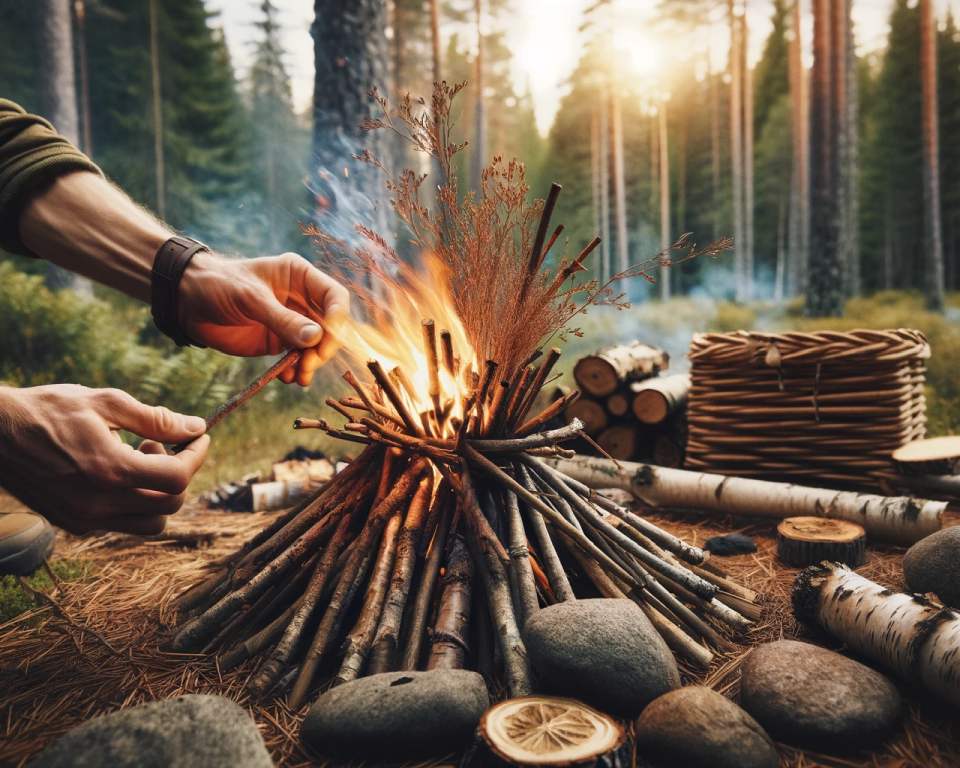
Gathering and cutting kindling is crucial to keep your fire going. Look for dry twigs and branches of various sizes that will easily catch fire and maintain a steady flame.
Making a feather stick is a handy technique to increase surface area and facilitate fire ignition. Using your knife, carve thin curls along a section of a dry stick. These curls will quickly catch flames, helping you start your fire.
Choosing a safe fire site is essential to prevent accidental wildfires. Look for areas without overhanging branches, dry grass, or flammable debris. Clear the area, create a fire ring using rocks, and ensure you have a water source nearby to extinguish the fire if needed.
Understanding fire safety and proper fire extinguishing techniques is crucial for responsible outdoor enthusiasts. Always fully extinguish the fire by spreading the ashes, dousing it with water, and feeling the ashes to ensure there are no remaining hot spots.
Bushcraft Shelter Building Skills – Sheltercraft
Building a shelter in the wilderness is essential for protection from the elements. Whether you’re planning a long-term wilderness adventure or just a weekend camping trip, knowing how to create a suitable shelter is a vital bushcraft skill.
Depending on the regulations and the time you have available, you can choose between building a long-term bushcraft shelter or using a tent or tarp for temporary protection. Understanding different shelter-building techniques will equip you with the knowledge to adapt to various environments and situations.
Lean-tos
One popular sheltercraft technique is building a lean-to. This involves finding a large, sturdy tree and propping long branches or logs against it at an angle, creating a sloping roof structure. Cover the roof with branches, leaves, or other available materials to provide insulation and protect against rain or snow.
Debris Shelters
Debris shelters are another effective option for bushcraft shelter building. To construct a debris shelter, start by creating a sturdy framework using branches and sticks. Then, layer natural materials such as leaves, moss, or grass over the framework to create insulation and protection. The debris shelter is designed to blend in with the natural surroundings, providing camouflage and minimizing heat loss.
Hammocks
A hammock can be a comfortable and practical shelter option, especially in areas with abundant trees. Simply tie your hammock between two sturdy trees using strong ropes or webbing straps. Make sure the hammock is properly secured and at a height that allows for a gentle swinging motion. Consider using a rainfly or tarp above the hammock to provide protection from rain and wind.

By mastering bushcraft shelter building skills, you will be equipped to create a safe and comfortable haven in the wilderness. Whether you choose a lean-to, debris shelter, hammock, or another type of shelter, the key is understanding the environment and utilizing available resources to meet your needs.
Water Sourcing and Purification Skills
Finding and purifying water is a critical skill for wilderness survival. In bushcraft, we learn essential techniques for identifying water sources, collecting and storing water, and purifying it for safe consumption.
“Water, the elixir of life, is our most precious resource in the wild. We must equip ourselves with the knowledge and skills to source and purify water effectively.”
When it comes to water sourcing, we explore various methods to locate reliable water sources in the wilderness. This includes looking for signs such as vegetation, animal tracks, or natural depressions that may indicate the presence of underground water. It’s important to explore different areas and consider all potential sources to ensure access to clean water.
Once we find water, it’s crucial to collect and store it properly. Utilizing containers and improvised methods, we ensure that our water remains uncontaminated and readily available. We must also be mindful of the quantity of water we collect and consider factors such as climate, activity level, and emergency preparedness.
Purifying water is the final step in ensuring its safety. In bushcraft, we rely on various purification methods, such as boiling water over a campfire or using portable filtration systems. We prioritize the removal of harmful microorganisms, sediment, and other contaminants to make the water safe for consumption.
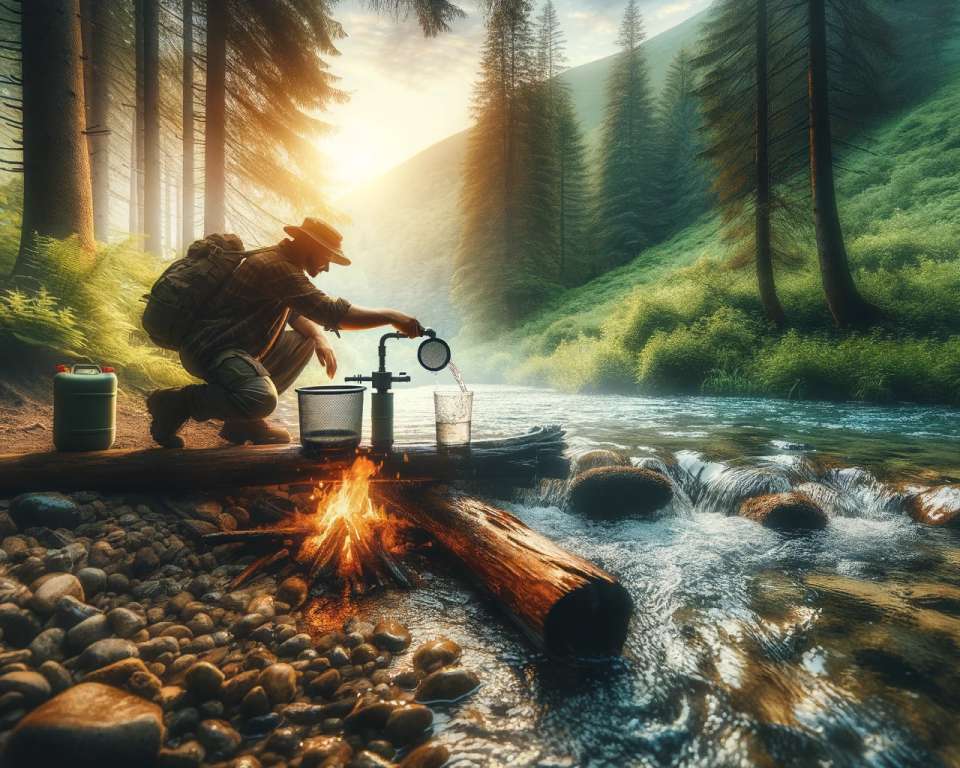
“Our water sourcing and purification skills in bushcraft enable us to stay hydrated and maintain our physical well-being while living in the wild.”
Understanding and honing our water sourcing and purification skills is vital for wilderness survival. By developing these skills, we can confidently navigate unfamiliar terrains, sustain ourselves in remote locations, and ensure our overall safety in the great outdoors.
Bushcraft Cordage Skills – Bindcraft
Cordage is an essential skill for any bushcraft enthusiast. It is the art of making strong and durable ropes or cords from natural fibers or synthetic materials like paracord. Having the knowledge of bindcraft enables you to create ropes that can be used for various tasks in the wilderness, such as building shelters, crafting tools, and creating traps.
Learning different cordage making techniques is key to mastering bindcraft. Natural fibers like plant stalks, tree bark, and animal sinew can be used to create strong ropes with the right knowledge and practice. Alternatively, paracord, a versatile and durable synthetic cord, is readily available and commonly used for bindcraft.
Understanding the strength and durability of different types of cordage is crucial. Different materials and techniques can result in cords with varying levels of tensile strength and resistance to wear and tear. This knowledge allows you to select the appropriate cordage for specific tasks, ensuring the success and longevity of your bushcraft endeavors.
By honing your bushcraft cordage skills, you enhance your ability to adapt and thrive in the wilderness. Whether it’s securing a shelter, lashing together tools, or fashioning snares for trapping game, bindcraft is an essential survival technique that every outdoor enthusiast should master.
Bushcraft Foraging Skills
Foraging for food and medicinal plants is a vital skill in the world of bushcraft. When exploring the wilderness, knowing how to identify edible plants can mean the difference between nourishment and hunger. By understanding the growing seasons and locations of various plants, we can ensure a successful foraging experience.
In addition to food, foraging can provide valuable resources for primitive living in the outdoors. Discovering plants with medicinal properties allows us to tap into nature’s remedies for common ailments. Mastering the art of bushcraft foraging skills equips us with the knowledge to sustain ourselves and thrive in the wild.
However, it is crucial to remember that proper foraging techniques incorporate safe harvesting practices. Respecting the environment and preserving plant populations are essential responsibilities we should uphold as outdoor enthusiasts. With these skills and principles, we tap into the abundance of the natural world while minimizing our impact.



